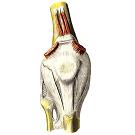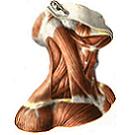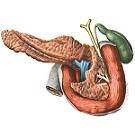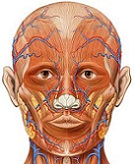Sacrum
The sacral vertebrae , vertebrae sacrales, number 5, grow together in the adult in a single bone - the sacrum.
Sacrum , os sacrum (sacrale), has the form of a wedge, is located under the last lumbar vertebra and participates in the formation of the posterior wall of the small pelvis. In the bone, the pelvic and dorsal surfaces are distinguished, two lateral parts, the base (the wide part facing upwards) and the apex (the narrow part directed downwards).

The anterior surface of the sacrum is smooth, concave, facing the pelvic cavity - this is the pelvic surface, facies pelvica. It preserves traces of fusion of the bodies of the five sacral vertebrae in the form of four parallel transverse lines, lineae transversae. Outside of them on each side there are four anterior pelvic sacrum apertures, foramina sacralia anteriora (pelvica) (through which the anterior branches of sacral spinal nerves and accompanying vessels pass).
The dorsal surface of the sacrum, facies dorsalis sacri, convex in the longitudinal direction, already anterior and rough. There are five row of rowing bones running down from above, formed as a result of the fusion of the spinous, transverse and articular processes of the sacral vertebrae.
The median sacral crest, crista sacralis mediana, was formed from the fusion of the spinous processes of the sacral vertebrae and is represented by four tubercles located one above the other, sometimes merging into one rough crest.
On each side of the median sacral crest, almost parallel to it there is one weakly pronounced intermediate sacral crest, crista sacralis intermedia. The crests were formed as a result of the fusion of the upper and lower articular processes. Outside them is a well-marked row of tubercles - lateral sacral crest, crista sacralis lateralis, which is formed by the fusion of transverse processes. Between the intermediate and lateral crests there are four posterior sacral orifices, foramina sacralia posteriora; They are somewhat smaller than the corresponding anterior sacral orifices (through them pass the posterior branches of the sacral nerves).
Across the longest rump is the sacral canal, the canalis sacralis, the curved shape, widened at the top and tapered below; It is a direct continuation down the spinal canal. The sacral canal communicates with the sacral orifices through the intervertebral openings inside the bone, foramina intervertebratia.
The base of the sacrum, the base of the ossis sacri, has a transversal-oval cavity - the junction with the lower surface of the body of the V lumbar vertebra. The anterior edge of the base of the sacrum at the junction with the V lumbar vertebra forms a protuberance - the promontory, promontorium, strongly protruding into the pelvic cavity. From the posterior base of the sacrum, the upper articular processes, the processus articulares superiores I of the sacral vertebrae, go upward. Their articular surfaces, facies articulares, are directed dorsally and medially and are articulated with the lower articular processes of the V lumbar vertebra. The posterior edge of the base (arch) of the sacrum with the upper articular protrusions protruding above it limits the entrance to the cruciform capal.
The top of the sacrum, apex ossis sacri. Narrow, blunt and has a small oval area - a junction with the upper surface of the coccyx; Here a sacrococcygeal joint articulatio sacrococcygea is formed, which is well expressed in young people, especially in women.
Behind the apex, on the posterior surface of the sacrum, the intermediate ridges terminate with two small protrusions - sacral horns, cornua sacralia - directed downwards. The posterior surface of the apex and the sacral horns border the outlet of the sacral canal - the sacral slit, hiatus sacralis.
The upper part of the sacrum-lateral part, pars lateralis, was formed by the fusion of the transverse processes of the sacral vertebrae.
The upper, flattened, triangular surface of the lateral part of the sacrum, the anterior margin of which passes into the boundary line, is called the sacral wing, ala sacralis.
Lateral surface of sacrum - articular auricularis, facies auricularis, articulates with the same surface of the ilium.
Behind and medially from the ear surface there is a sacral tuberosity, tuberositas sacralis, a trail of attachment of the sacroiliac interosseous ligaments.
Sacrum in men is longer, more and more curved than in women.
You will be interested to read this:









Comments
When commenting on, remember that the content and tone of your message can hurt the feelings of real people, show respect and tolerance to your interlocutors even if you do not share their opinion, your behavior in the conditions of freedom of expression and anonymity provided by the Internet, changes Not only virtual, but also the real world. All comments are hidden from the index, spam is controlled.